#North Pacific region
Explore tagged Tumblr posts
Text
No. 15 - PSA (Pacific Southwest Airlines)

Thank you to @lobstersinmyhouse for requesting PSA! And, in all honesty, this is exactly my feelings too. Pack it up, post over.
...okay, no. I am going to write a post, but I make no secret of loving PSA's airplanes. After all, one is even my icon.

image: Piergiuliano Chesi
There was never an airline like it before PSA sprang up in 1949, and there has never been an airline like it since. Decades after its demise I still feel a real sense of grief about the fact that it's gone. Pacific Southwest Airlines hasn't existed for longer than its entire time in operation and it mostly only operated in a single state, but it remains one of the most beloved airlines ever to exist. I'm certainly far from immune to catching their smile. So I'm very, very excited to cover the iconic grinningbirds, one of the best-known airline liveries of all time even 40 years after the regional carrier which wore it ceased existing.
youtube
PSA officially stands for Pacific Southwest Airlines. Unofficially, it was the Poor Sailor's Airline. According to a button they put out, it was this.

image: psa-history.org
But really, it can stand for anything you want. I think it stands for Pretty Smiling Airplanes.
You see, PSA's marketing leaned into the fun and casual as much as it was possible for an airline to do. They called themselves "The World's Friendliest Airline". Their branding was all bright, colorful, delightful. One aspect of it is particularly well known.
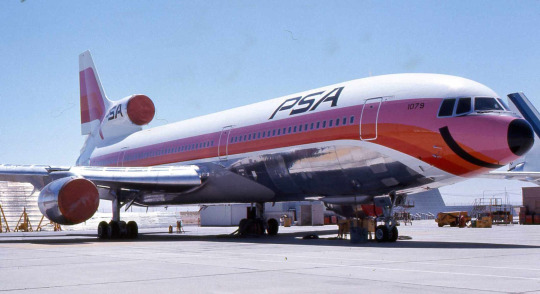
image: Piergiuliano Chesi
The name "grinningbird" is literal. PSA's fleet was lovingly painted with massive smiles directly under their noses. Their advertisements encouraged people to "catch our smile" across the state of California.

A preserved DC-3 in original Pacific Southwest livery
PSA was started as a single leased DC-3 hopping from San Diego to Oakland. Apparently their ticket office was literally a refitted military surplus latrine where they weighed passenger baggage on a bathroom scale. When they expanded with DC-4s they painted rectangles around the windows to make them look more like DC-6s. This was in 1955. And then, by the early 60s, they were taking off.


A pre-smile PSA Electra. The L-188 Electra is, of course, my favorite jet plane. image: Jon Proctor
It was in the 60s that their planes stopped saying 'Pacific Southwest Airlines' and started just being PSA, and it was in the 60s when they caught their smiles. This was the point when PSA became PSA, transforming from just another intrastate airline in the pre-deregulation era to a turning point in aviation history.
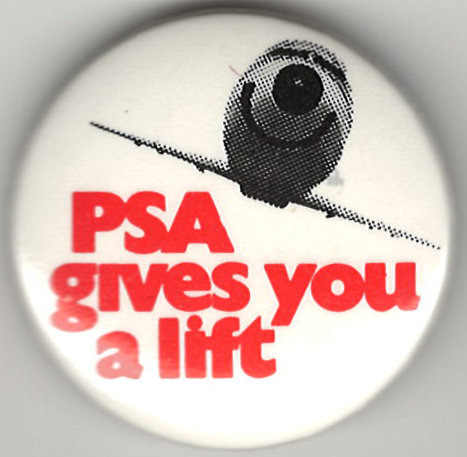
a 1972 promotional button image: psa-history.org
While the smiley faces are the most significant historical fact about PSA, also notable is the fact that they were the first low-cost carrier in history. Although PSA's routes were limited to Southern California, they charged $9.99 for a ticket other airlines would charge $13.50 or $22.05 for - and keep in mind that in today's money that's a difference of hundreds of dollars. Free of federal fare taxes and operating frequently, PSA grew at an intense pace with its new fleet of Lockheed L-188 Electras.

I love the L-188 Electra (not to be confused with the earlier L-10 Electra best known for Amelia Earhart reasons). Although Lockheed has long since moved over to exclusively making weapons for killing people, back when they were in the civil airliner market they made the most incredible planes which somehow ended up commercially flopping time after time. The Electra, for instance, was all but killed immediately by two early crashes caused by a sneaky design flaw. These were fixed, but the type's reputation had already been sullied. (Interestingly, similar early design flaws with far less prompt responses failed to kill either the DC-6 or the DC-10, despite the latter causing the deadliest crash in history at the time and the former having had the serious potential to give us a timeline where the President of the United States was killed because his presidential transport had a design flaw which encouraged going up in flames midair.) Ironically, the Electra is actually an insanely reliable and sturdy plane, and the example pictured is still in service as an air tanker under the registration C-GZCF, still doing her thing at just 63 years young. (Another Electra in Air Spray's fleet is a similar age but also survived being bisected across the belly by her own detached propeller, and she literally flew two days ago. These planes are on a level only shared with Nokia cell phones, especially for their size.)
That paragraph became about the Lockheed L-188 Electra. I did not mean for it to be, but I am leaving it in, because I love this plane. Looks great with the smile, too. The roundness of the nose gives the distinct appearance of something like a teddy bear snout.
From this point things only grew quicker. PSA continued to be PSA, acquiring more aircraft to fly more passengers. They did expand routes eventually, and once the 1978 Deregulation Act allowed they flew to some other states and even Mexico. Despite this, they remained an icon in their home state, and are often called "the unofficial flag carrier of California".

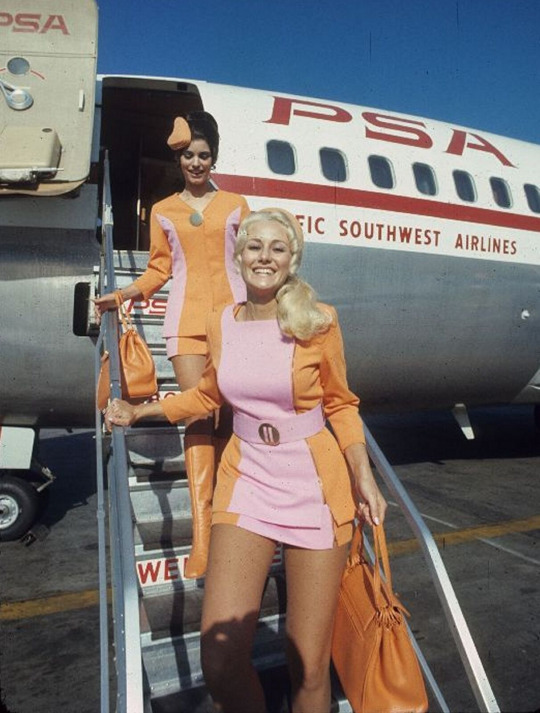
PSA stewardesses. I can't find an original source for either of these pictures, which have been widely spread without context or credit - although significant effort has been made to archive PSA's promotional content, a lot of it is, sadly, free-floating orphaned bits.
PSA's stewardesses wore bright pink and orange uniforms of miniskirts, hot pants, and go-go boots. They were encouraged to joke around with passengers, and so were the pilots. Other airlines at the time were still only slowly losing the unapproachable aura they had cultivated of stiff, sterile luxury and gravitas. PSA would get you where you needed to go without any fuss and they'd charge you half as much for it. And they weren't sloppy, either. Despite their low fares, PSA was incredibly safe, having one fatal accident in a span of time where American Airlines had 16, and even though nostalgia is obviously a factor I've only ever heard glowingly positive accounts of PSA, its service, and its staff.

image: Bill Larkins
PSA's fleet was...eclectic. Though they operated a few very popular models, like the Boeing 727 and McDonnell Douglas MD-80 series, a lot of their offerings were somewhat uncommon. The plane in my profile picture is one of their two L-1011 TriStars, another of Lockheed's underappreciated airliners and by far the most advanced wide-body aircraft of its time. PSA was unique in that it operated a jumbo jet, their "Mother Grinningbird", on a route that was not just domestic, but intrastate. They also apparently operated a single Bell 206 helicopter, which I can find no additional clarification on. Lastly, they flew one of the oddest airliners ever built in both function and appearance, the British Aerospace 146.

Just your regular high-wing jet. No thrust reversers necessary. Western-made but rocking the Il-76 wing anhedral. Super quiet because the powerplants are based off what you'd put on a helicopter. Seats less people than a 737-200 - six-across layout for maximum discomfort - and flies exclusively puddle jumps...yeah, I think four sounds like the right number of engines. image: Ted Quackenbush
Across all these planes, they found a livery that worked and they kept going with it. The reason this post is so long is to give context to just how important this livery is. The grinningbirds were what started low-cost carriers, paving the way for the silly names of jetBlue airplanes in a future its founders couldn't even have imagined. The shift to approachability over prestige in airline marketing was PSA's lasting gift to aviation, as were the low fares and the knowledge that a 'budget' airline didn't have to be dodgy or unpleasant - they just had to charge less than TWA and Western.

image: Piergiuliano Chesi
PSA's colorscheme was incredibly vibrant. The red and orange colors feel warm and tropical, complementing the California sunshine in which these planes spent their time. Earlier liveries also had a shocking hot pink shade above both, though it was eventually painted over due to issues with paint fading - I think the livery is vastly improved with its presence, but I suppose needs must. Despite the airline serving commuters more than vacationers it puts one in mind of things like beaches and ice cream stands - warm, high-energy things. The sorts of things one might smile about, if they like those things. I hate those things, but these planes make me like the idea of them, because they're just so darn happy to take me there!
The design of the fuselage is incredibly bold despite not using much more paint than any other airline of the day. While the striking colors definitely contribute to the overall look being more than the sum of its parts, I think there's also a few bits of clever design that really elevate the design of the plane.

The tail has a design almost like an inverse hockey-stick. Instead of following the cheatlines for maximum sleekness it chooses to diverge from it, creating a sharp angle that keeps the aerodynamic feeling while feeling fresh from similar designs of the time. By having the thin line from the tail trailing down towards the fuselage it prevents the block of empty space on a regular hockey-stick livery, where the forward portion of the empennage is fully unpainted, and creates a feeling of continuous color and excitement while keeping some staccato punch.
Similarly subtle yet effective are the stripes themselves. They aren't of an equal width - rather, the red stripe is thinner than the orange one, and in planes with the additional pink stripe this one is even wider. It feels a lot more dynamic than simple even-width stripes, feeling almost as if you can see the colors start to mix into each other. The 'mixing' feeling is helped by the fact that the cheatlines wrap under the nose instead of simply ending where they meet. The small painted white line under the main colored ones, above the unpainted metal of the underbelly, creates basically an extra two stripes for the price of one despite being so subtle many people probably didn't notice it.
On its own, the design of the bodies of PSA planes is already good, but it practically ceases to matter when you get to the face.


The way the top line of color wraps around the back of the cockpit windows makes it look almost like the plane is wearing sunglasses. And then there's the little painted black nose and, of course, the huge ear-to-ear grin. I don't really know what else to say about this because it's all been said time and time again.
I genuinely don't know how else to express it. PSA's livery was gorgeous and it was perfect for PSA. In all honesty, I don't think it's possible to improve it at all. My one slight criticism is that the actual PSA wordmark, though designed well, is a bit small and out of the way, but to be totally honest it's barely necessary. You see the smile and you know exactly who that plane is flying for.
PSA gets a PSA+.

So what happened to PSA, if they were so successful? Did an economic shift catch them off-guard? Did some demographic evolution rob them of their old customer-base? Did a change of management result in a new owner running the airline into the ground? Did it have anything to do with the fact that the one time they were involved in an accident it spent eight months as the deadliest crash in US history?
Nope. They got bought out by USAir because they wanted more routes on the West Coast.
Yeah. That's the story. Neither a bang nor a whimper. They left one morning and didn't come back. That was the end of PSA, the first-ever low-cost carrier, California's most beloved airline, and one of the best-designed liveries in airline history if not the very best.
There is, however, one final twist. USAir eventually was sucked into the gaping maw of American Airlines. With this merger American Airlines also inherited the rights to PSA's IP. In classic fashion, they created a wholly-owned subsidiary by the name of PSA Airlines, just to make sure nobody else could get the trademark.


Under the iron fist of first US Airways (USAir's eventual rebrand) and later American Airlines, we were allowed one last grinningbird - an Airbus A319-100 registered N742PS. It's strange, seeing the PSA livery on a model of airplane they never operated. It's a rare example of the design on airframes that have that rather distinct 'default' modern empennage, all sharp and tall with no t-tail or third engine. The implementation could take some notes and the colors look bizarrely plastic, but I will never stop loving her no matter how much they take from her. How could I not, with that smile?
Unfortunately, in April of this year she was re-painted to a standard American Airlines livery. Although the Allegheny and Piedmont heritage liveries were removed at the same time, I almost don't even notice their absence because of the loss of our very last holdout from a much more colorful time and place. Part of me feels a sort of ripping-the-bandaid-off relief at it. American Airlines shouldn't get to parade around the skin of a much better livery worn by a much better airline. That isn't theirs; they didn't earn it. And there's no way to rebuild PSA now that times have changed and the industry is unrecognizable from the days when a ticket from San Diego to Burbank cost $9.99. All the same, the loss of yet another smile hurts. There's no way it wouldn't. And at the end of the day it makes me feel a little dead inside just imagining the mindset of the American Airlines executive who walked by her in the hangar and instead of smiling back gave the order to paint her white. And that day, the sky got a little less colorful and a lot sadder.
Maybe, in a strange sense, the way it happened is better. Nobody ran PSA into the ground. They did not cause some sort of reputation-ruining accident through willful negligence. Their customer service did not decline until they were widely grumbled about. They didn't die infamous for poor safety and loose morals like Pan Am, or splitting at the seams and betraying their reputation like Chalk's Ocean Airways. No, I don't think an organic shriveled going-under would have held any more dignity than this. I think the ending PSA got is as graceful as the ending to something like PSA could be. There is no end to the glory days which forces itself into our memories. There is no decline. No sunset to fly off into. There is a loss to mourn, but no accompanying moment to curse. Lost at sea, ship never found, nothing to imply a terrible fate; all we know is the poor sailors aren't here anymore.
Maybe it's not universally known to people who aren't interested in subjects that bring them close to it, but to those of us who love planes PSA is truly special. Its quiet apotheosis has made it synonymous with the very best an airline could be. The joy of a time where a regular person could finally afford their first plane ticket and be greeted by colorful people who talk to them like friends, where even the planes are smiling, is encoded into the DNA of PSA's remnants, into every anecdote told by an aging former stewardess and into every Polaroid taken of one of those smiling planes parked on a sunny California tarmac. It was there, and then it was a distant echo of warm breezes and idle chatter that feels almost close enough to reach out and touch. PSA never died. One day it was flying passengers to their destinations, planes smiling their same smiles. The next day it was fond memory, already graduated to the distant sunny shores of nostalgia.
youtube

#tarmac fashion week#grade: a+#region: north america#region: united states#era: 1960s#era: 1970s#era: 1980s#pacific southwest airlines#requests#defunct airlines#regional airlines#double sunrise#long haul#galley gala
106 notes
·
View notes
Text
the problem with building out america's rail network btw is that it's privatized and there will never be a corporate incentive strong enough or backed enough to implement effective, accessible, AND privatized countrywide travel. nationalize railways deliver on the demands of railway workers and most importantly respect indigenous sovereignty/include indigenous design input when plotting routes
#and a million other things mostly to do with geology but in terms of politics and morals this is what im going with as far as a snappy#summary of 'the problem'#however geology elaboration: america is So hard to build railways across because our most populated areas along the west coast#(where most of the rail drought is; rail PRICING on the east coast is a whole nother thing)#are stupid mountainous. the california hsr plan is spending several million more on the rail line bc they gotta plan around a mountain#and the problem gets worse the farther north you get on account of the cascades and ESPECIALLY the region around shasta#in another life i was a seismic engineer. anyway#i'm looking for a papers or other peer-reviewed content on the history of american rail labor#if anyone has favorites send them my way cause all my research is locked on california and the pacific coast more broadly#'research' my font of pdfs i downloaded from ILLs lol
35 notes
·
View notes
Text


An arbutus (two views) for #ThickTrunkTuesday
#photo#photography#yyj#victoria#bc#North Saanich#Cole's Bay Regional Park#trees#arbutus#Pacific madrone#Douglas fir#Thick Trunk Tuesday
2 notes
·
View notes
Text
Excerpt from this story from Smithsonian Magazine:
For the first time in 112 years, Chinook salmon are swimming freely in the Klamath Basin in Oregon.
On October 16, biologists with the Oregon Department of Fish and Wildlife (ODFW) spotted the fish above the former site of the J.C. Boyle Dam in the Upper Klamath River. The dam was one of four that had blocked the salmon’s migration between the Klamath Basin and the Pacific Ocean. Each of those dams was recently deconstructed in the largest dam removal project in United States history, which has restored the river to its natural, free-flowing state.
At first, biologists wondered if they had really sighted a salmon. “We saw a large fish the day before rise to surface in the Klamath river, but we only saw a dorsal fin,” says Mark Hereford, leader of ODFW’s Klamath Fisheries Reintroduction Project, in a statement. “I thought, was that a salmon, or maybe it was a very large rainbow trout?”
But when the team returned on October 16 and 17, they were able to confirm the fall-run Chinook—making them the first to spot the species in the region since 1912.
The return of the salmon comes less than two months after the end of the dam removals in California and Oregon, an effort that took decades of advocacy by the surrounding tribes—including the Yurok, Karuk, Shasta, Klamath and Hoopa Valley, among others—whose people have deep ties to the Chinook salmon.
Ron Reed, a Karuk tribe member and traditional fisherman, participated in the campaigns for dam removal, advocating that the river’s restoration would help salmon recover. He isn’t surprised the fish have returned so quickly to their ancestral waters, he tells the Los Angeles Times’ Ian James.
“The fact that the fish are going up above the dams now, to the most prolific spawning and rearing habitat in North America, it definitely shines a very bright light on the future,” Reed tells the Los Angeles Times. “Because with those dams in place, we were looking at extinction. We were looking at dead fish.”
In one poignant case, tens of thousands of Chinook salmon died off in the span of days in 2002, as the water quality in the dammed Klamath River deteriorated from the lack of flow. The dams, built between the early 1900s and 1962, also contributed to algae blooms and diseases, and they blocked the salmon’s annual migration.
3K notes
·
View notes
Text
Analysis of data from dozens of foraging societies around the world shows that women hunt in at least 79% of these societies, opposing the widespread belief that men exclusively hunt and women exclusively gather. Abigail Anderson of Seattle Pacific University, US, and colleagues presented these findings in the open-access journal PLOS ONE on June 28, 2023. A common belief holds that, among foraging populations, men have typically hunted animals while women gathered plant products for food. However, mounting archaeological evidence from across human history and prehistory is challenging this paradigm; for instance, women in many societies have been found buried alongside big-game hunting tools. Some researchers have suggested that women's role as hunters was confined to the past, with more recent foraging societies following the paradigm of men as hunters and women as gatherers. To investigate that possibility, Anderson and colleagues analyzed data from the past 100 years on 63 foraging societies around the world, including societies in North and South America, Africa, Australia, Asia, and the Oceanic region. They found that women hunt in 79% of the analyzed societies, regardless of their status as mothers. More than 70% of female hunting appears to be intentional—as opposed to opportunistic killing of animals encountered while performing other activities, and intentional hunting by women appears to target game of all sizes, most often large game. The analysis also revealed that women are actively involved in teaching hunting practices and that they often employ a greater variety of weapon choice and hunting strategies than men.
These findings suggest that, in many foraging societies, women are skilled hunters and play an instrumental role in the practice, adding to the evidence opposing long-held perceptions about gender roles in foraging societies. The authors note that these stereotypes have influenced previous archaeological studies, with, for instance, some researchers reluctant to interpret objects buried with women as hunting tools. They call for reevaluation of such evidence and caution against misapplying the idea of men as hunters and women as gatherers in future research. The authors add, "Evidence from around the world shows that women participate in subsistence hunting in the majority of cultures."
23K notes
·
View notes
Text
Jackson Hinkle: Western Elites Want War Against Russia, China
The US Establishment is Not Hesitant to Start World War III to Maintain its Globalist Dominance, American Political Commentator Jackson Hinkle told Sputnik's New Rules Podcast.
— Sputnik International | September 23, 2023

B-52H Stratofortresses from the 2nd Bomb Wing line up on the runway at Barksdale Air Force Base, Louisiana., October 14, 2020. The B-52 is a long-range, heavy bomber that can perform a variety of missions and has been the backbone of U.S. strategic bomber forces for more than 60 years. - Sputnik International. © Senior Airman Tessa Corrick
"I guess Tucker [Carlson] has got a point when he says, 'I'm willing to bet my house that Joe Biden is going to start World War Three with Russia,' because look what they've done," Jackson Hinkle told Sputnik. "These people are insane. Even like, taking [ex-House Speaker Nancy] Pelosi on her jet to go to Taiwan and meet with Taiwanese officials. There was a lot of people, myself included, who were thinking, 'Goodness, the [Chinese] People's Liberation Army (PLA) is going to shoot her out of the sky or something right now? Is this going to be how it all begins?' They're reckless. They are completely Russophobic and beating the drums of war to go to war with China."
Moreover, the American elite's hostility toward Russia has surpassed that of the Cold War era, leading to a worrying breakdown in communications between Washington and Moscow, according to the political commentator.
"The level of communication breakdown is so severe compared to the Cold War," he said. "I got to meet the guy that actually developed the telephone, they had the red hotline telephone between the US and the USSR during the Cold War. And he told me he’s like, 'there's nothing like that right now in the White House. There's no communication whatsoever.' And we're not too far off from that same sort of a lack of dialogue with the Chinese, because they want to go to war against the Chinese."
It did not happen overnight, according to the analyst. Over the past 30 years, Washington and its allies have reneged on all the pledges they made to Moscow at the end of the Cold War. One of them was a verbal promise that NATO would not extend an inch east of Germany. "NATO since then, at the behest of the US, has violated that promise on 16 occasions now," Hinkle remarked. The transatlantic alliance does not conceal its plans to draw in Ukraine and possibly Georgia, thus moving even closer to Russia's borders.
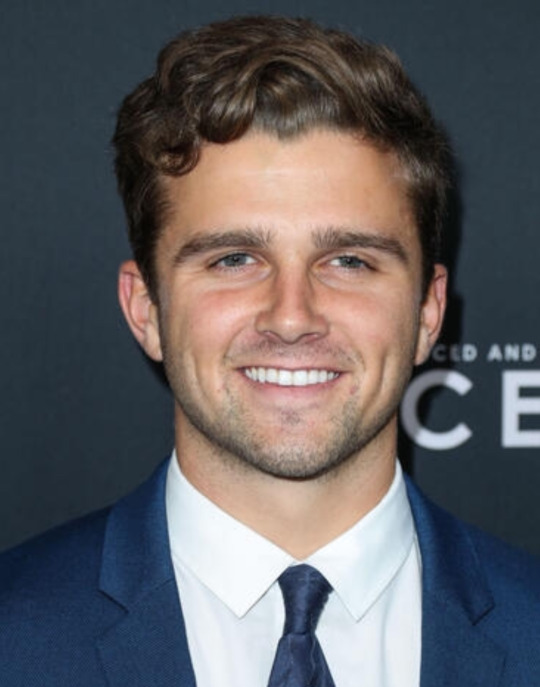
Jackson Hinkle. “These people are insane. Even like taking Pelosi on her jet to go to Taiwan and meet with Taiwanese officials. There was a lot of people, myself included, who were thinking, "goodness, PLA is going to shoot her out of the sky or something right now? Is this going to be how it all begins?" They're reckless. They are completely Russophobic and beating the drums of war to go to war with China,” Jackson Hinkle, host of The Dive, told Sputnik.
US Elites Seek to Dismantle Economic Alternative Offered by Russia & China
The emergence of a multipolar world order - with Russia and China at the forefront of the movement - is challenging the globalist Great Reset aimed at prolonging centuries of Western colonial hegemony, according to Hinkle.
"[The multipolar world] poses a serious threat to the West's effort to secure the Eurasian heartland, which that's been like the basis of US foreign policy for so long, is to have control over the people and the resources in the Eurasian heartland, which of course encompasses Russia," Hinkle said. "And now that Russia and China and these other countries more and more and more are working together to form BRICS and develop a new currency that's going to challenge the dollar, I would be worried if I was the United States and I was also refusing to do business with them. We could just do business with them and we'd all win, but they're not going to do that."
At the recent BRICS summit, held in Johannesburg, South Africa, in August, the group's participants condemned the West's unfair trade practices and unilateral sanctions and discussed the increased use of national currencies and domestic financial mechanisms instead of the US dollar. The Global South leans toward Russia and China, whose economies have proven remarkably resilient despite Western predictions of imminent collapse. Moreover, in terms of purchasing power parity (PPP), China has overtaken the US as the world's largest economy. Russia, for its part, overtook Europe's three largest economies - France, the UK and Germany - in PPP terms in 2022.
"The State Department and Wall Street are very concerned," the US political analyst said. "I think the State Department currently, as it presents itself, is just a tool of Wall Street, because what is Wall Street? Wall Street is just this Byzantine labyrinth of predatory economic schemes. It's rent, it's interests. It's speculation on stocks. All of this is just BS. It's nothing. And at the end of the day, when you compare that sort of an economy to what China and Russia represent, which is real production that's aimed at uplifting the public good, China's lifted 840 million people out of poverty over the last 40 years through developing oil, gas, coal, doing land reform, silver, gold, all these things and more, agricultural goods. Yeah, that is a challenge to the West, and it's a substantive one because the West doesn't produce anything anymore. We outsourced all our manufacturing. So what is left? Nothing, really. And that can crumble very easily if there's a real challenge." — Jackson Hinkle, American Political Commentator
Russia and China Aren't Enemies of US People
It's not Russia and China that pose a real threat to Americans, Hinkle emphasized, but those who hoard all U.S. resources and act contrary to U.S. national interests.
"We have this rich group of people in America that are hoarding all of our resources. Some of these large investment firms like BlackRock and Vanguard. (…) BlackRock, they're making money off of all this real estate. Bill Gates is as well. Why is it that they get to buy up all the real estate, but 60,000 American veterans have to sleep out on the streets every night? That's supposed to be acceptable, and we're not supposed to question that?" Hinkle asked.
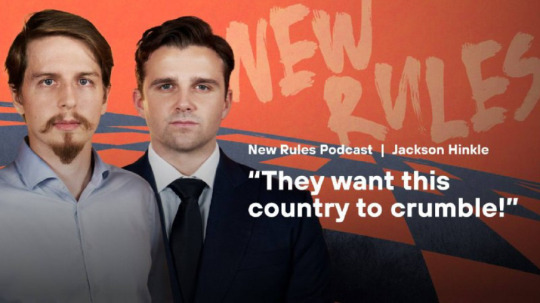
“Average Americans are being put in prison because they can't pay their taxes, because we're sending $250 billion to Ukraine, and hundreds of millions to Taiwan. Anyone who thinks that Russia or China is our enemy is sorely mistaken. Our enemy is Wall Street, World Economic Forum, the DC Beltway region and the city of London,” Jackson Hinkle, host of the Dive, told the New Rules podcast, commenting on the real enemies of the American people.
"There is no reason for them to be running free on yachts and traveling back and forth to Lake Como, to the Hamptons and wherever when average Americans are being put in prison because they can't pay their taxes, because we're sending $250 billion to Ukraine, and hundreds of millions to Taiwan. The people that are our enemies are really this globalist class of finance capital that are sucking out every last bit of breath from the American public in the working class. For anyone who thinks that Russia or China or whoever is our enemy, they're sorely mistaken. Your enemy is Wall Street, World Economic Forum, the DC Beltway region and the City of London," the political commentator continued.
The neocons in the Biden administration, Wall Street and the U.S. military-industrial complex have already profited from Washington's proxy war in Ukraine and are salivating at the opportunity to profit even more from the US conflict with China. However, these overseas conflicts have nothing to do with core US interests. What's worse, these proxy wars would most certainly backfire, according to the analyst.
"I think a lot of people have their eyes set on China and a war with China, and I think that's what they really want. And I think that [they’re also eyeing] a war with Russia. I pray that there's no World War Three with Russia. That's how it starts," Hinkle concluded.
#Analysis | US 🇺🇸 | Joe Biden | Russia 🇷🇺 | China 🇨🇳 | World 🌎 | BRICS | North Atlantic Terrorist Organization (NATO) | White House#Ukraine 🇺🇦 | Taiwan 🇹🇼 | Asia-Pacific Region | Pivot to Asia | Europe | Wall Street | BlackRock#Opinion#Sputnik International#Ekaterina Blinova
0 notes
Text
Question for USAmericans...

Please reblog for larger sample size :)
2K notes
·
View notes
Text
Solar Powered Outdoor Lights Market Analytical Overview and Growth Opportunities by 2032
The solar-powered outdoor lights market has been experiencing significant growth due to increasing environmental awareness and the growing adoption of sustainable energy solutions. Solar-powered outdoor lights utilize solar panels to convert sunlight into electricity, eliminating the need for traditional power sources. These lights are widely used for outdoor illumination in residential, commercial, and industrial settings.
Analysis:
The solar-powered outdoor lights market is expected to witness robust growth during the forecast period, driven by the increasing demand for sustainable lighting solutions.
North America and Europe are anticipated to dominate the market due to stringent regulations promoting renewable energy adoption.
Asia Pacific region is expected to experience significant growth, supported by rapid urbanization and government initiatives in countries like China and India.
Technological advancements, such as improved solar panel efficiency and battery storage capabilities, are expected to drive market growth.
Key challenges include the high upfront cost of solar-powered outdoor lights and the limited availability of sunlight in certain regions. However, declining solar panel costs and advancements in battery technology are mitigating these challenges.
Growth Opportunities:
Increasing government initiatives promoting renewable energy and energy-efficient lighting solutions.
Growing demand for smart solar-powered outdoor lights integrated with advanced technologies like motion sensors and remote control capabilities.
Rapid urbanization and infrastructure development in emerging economies, driving the need for reliable and sustainable lighting solutions.
Rising consumer awareness about the benefits of solar energy and the need to reduce carbon footprints.
Technological advancements leading to improved efficiency, longer battery life, and enhanced aesthetics of solar-powered outdoor lights.
Key Points:
Solar-powered outdoor lights offer significant cost savings over traditional lighting solutions, as they eliminate electricity bills and reduce maintenance costs.
These lights are environmentally friendly, as they do not emit harmful greenhouse gases and reduce reliance on fossil fuels.
Solar-powered outdoor lights provide reliable illumination even in remote areas without access to electricity grids.
The market is witnessing increased collaborations and partnerships among key vendors to expand their product portfolios and geographical presence.
The integration of solar-powered outdoor lights with smart home systems and IoT technologies is opening up new opportunities for market growth.
We recommend referring our Stringent datalytics firm, industry publications, and websites that specialize in providing market reports. These sources often offer comprehensive analysis, market trends, growth forecasts, competitive landscape, and other valuable insights into this market.
By visiting our website or contacting us directly, you can explore the availability of specific reports related to this market. These reports often require a purchase or subscription, but we provide comprehensive and in-depth information that can be valuable for businesses, investors, and individuals interested in this market.
“Remember to look for recent reports to ensure you have the most current and relevant information.”
Click Here, To Get Free Sample Report: https://stringentdatalytics.com/sample-request/solar-powered-outdoor-lights-market/6229/
Market Segmentations:
Global Solar Powered Outdoor Lights Market: By Company • Greenshine New Energy • SBM-SolarTech • Signify Holding • Jiawei • LEADSUN • OkSolar • SEPCO Solar Electric Power Company • SOKOYO • Solar Street Lights USA • Sunna Design SA Global Solar Powered Outdoor Lights Market: By Type • Less than 39W • 40W to 149W • More than 150W Global Solar Powered Outdoor Lights Market: By Application • Residential • Commercial • Industrial • Goverment Global Solar Powered Outdoor Lights Market: Regional Analysis All the regional segmentation has been studied based on recent and future trends, and the market is forecasted throughout the prediction period. The countries covered in the regional analysis of the Global Solar Powered Outdoor Lights market report are U.S., Canada, and Mexico in North America, Germany, France, U.K., Russia, Italy, Spain, Turkey, Netherlands, Switzerland, Belgium, and Rest of Europe in Europe, Singapore, Malaysia, Australia, Thailand, Indonesia, Philippines, China, Japan, India, South Korea, Rest of Asia-Pacific (APAC) in the Asia-Pacific (APAC), Saudi Arabia, U.A.E, South Africa, Egypt, Israel, Rest of Middle East and Africa (MEA) as a part of Middle East and Africa (MEA), and Argentina, Brazil, and Rest of South America as part of South America.
Visit Report Page for More Details: https://stringentdatalytics.com/reports/solar-powered-outdoor-lights-market/6229/
Reasons to Purchase Solar Powered Outdoor Lights Market Report:
• To obtain insights into industry trends and dynamics, including market size, growth rates, and important factors and difficulties. This study offers insightful information on these topics.
• To identify important participants and rivals: This research studies can assist companies in identifying key participants and rivals in their sector, along with their market share, business plans, and strengths and weaknesses.
• To comprehend consumer behaviour: these research studies can offer insightful information about customer behaviour, including preferences, spending patterns, and demographics.
• To assess market opportunities: These research studies can aid companies in assessing market chances, such as prospective new goods or services, fresh markets, and new trends.
• To make well-informed business decisions: These research reports give companies data-driven insights that they may use to plan their strategy, develop new products, and devise marketing and advertising plans.
In general, market research studies offer companies and organisations useful data that can aid in making decisions and maintaining competitiveness in their industry. They can offer a strong basis for decision-making, strategy formulation, and company planning.
About US:
Stringent Datalytics offers both custom and syndicated market research reports. Custom market research reports are tailored to a specific client's needs and requirements. These reports provide unique insights into a particular industry or market segment and can help businesses make informed decisions about their strategies and operations.
Syndicated market research reports, on the other hand, are pre-existing reports that are available for purchase by multiple clients. These reports are often produced on a regular basis, such as annually or quarterly, and cover a broad range of industries and market segments. Syndicated reports provide clients with insights into industry trends, market sizes, and competitive landscapes. By offering both custom and syndicated reports, Stringent Datalytics can provide clients with a range of market research solutions that can be customized to their specific needs
Contact US:
Stringent Datalytics
Contact No - +1 346 666 6655
Email Id - [email protected]
Web - https://stringentdatalytics.com/
#Solar Powered Outdoor Lights Market Analytical Overview and Growth Opportunities by 2032#The solar-powered outdoor lights market has been experiencing significant growth due to increasing environmental awareness and the growing#eliminating the need for traditional power sources. These lights are widely used for outdoor illumination in residential#commercial#and industrial settings.#Analysis:#•#The solar-powered outdoor lights market is expected to witness robust growth during the forecast period#driven by the increasing demand for sustainable lighting solutions.#North America and Europe are anticipated to dominate the market due to stringent regulations promoting renewable energy adoption.#Asia Pacific region is expected to experience significant growth#supported by rapid urbanization and government initiatives in countries like China and India.#Technological advancements#such as improved solar panel efficiency and battery storage capabilities#are expected to drive market growth.#Key challenges include the high upfront cost of solar-powered outdoor lights and the limited availability of sunlight in certain regions. H#declining solar panel costs and advancements in battery technology are mitigating these challenges.#Growth Opportunities:#Increasing government initiatives promoting renewable energy and energy-efficient lighting solutions.#Growing demand for smart solar-powered outdoor lights integrated with advanced technologies like motion sensors and remote control capabili#Rapid urbanization and infrastructure development in emerging economies#driving the need for reliable and sustainable lighting solutions.#Rising consumer awareness about the benefits of solar energy and the need to reduce carbon footprints.#Technological advancements leading to improved efficiency#longer battery life#and enhanced aesthetics of solar-powered outdoor lights.#Key Points:#1.#Solar-powered outdoor lights offer significant cost savings over traditional lighting solutions#as they eliminate electricity bills and reduce maintenance costs.
0 notes
Text











Подводные бабочки-рыба, которой даны крылья, но не для полета- Восточная дактилоптена.
Восточная дактилоптена, или восточная летучка (лат. Dactyloptena orientalis), — вид лучепёрых рыб семейства долгопёровых (Dactylopteridae). Широко распространены в Индо-Тихоокеанской области от юга Африки до Красного моря и Персидского залива, включая Мадагаскар и Маскаренские острова. На север до Японии и островов Бонин; на восток до Тонга, Рапа-Ити, Гавайских островов и островов Питкэрн и на юг до Западной Австралии, Нового Южного Уэльса и Новой Каледонии. Максимальная длина тела 40 см, обычно до 20 см
Тело у этих необычнх рыб массивное, удлинённое, почти квадратное в поперечном сечении. Покрыто костной чешуёй, которая образует продольные гребни. Голова большая и заключена в костный панцирь. Глаза у дактилоптены большие. Рот маленький, полунижний с крошечными зубами на обеих челюстях, сошнике и нёбных костях. В углу предкрышки расположен длинный шип; его окончание не заходит за окончание первой спинной колючки. У восточной летучки два спинных плавника; в первом спинном плавнике 5 колючих лучей; второй спинной плавник с 8 мягкими лучами отделён от первого спинного плавника глубокой выемкой. Хвостовой плавник с небольшой выемкой, удлинённый у взрослых особей. Грудные плавники с горизонтальным основанием, разделены на две части: передней, образованной пятью короткими лучами, и задней с 27—30 длинными лучами, окончания которых доходят до основания хвостового плавника; каждый луч с короткими нитями, выходящими за внешний край луча.
Окраска тела обычно желтовато-коричневая сверху и светло-коричневая снизу. По верхней части головы и тела разбросаны небольшие оранжевые точки; у особей крупнее 10 см обычно на верхней части головы есть большое тёмное пятно. На грудных плавниках беспорядочно разбросаны золотистые точки, более крупные в задней части. У мелких особей (длиной 50—65 мм) одно глазчатое тёмное пятно на нижней трети плавников. По хвостовому плавнику проходят четыре золотистые полосы. Золотистые полосы идут вдоль верхней части колючего спинного плавника.
Восточная дактилоптена это морская придонная рыба. Обитает на континентальном шельфе над песчаными грунтами на глубине от 1 до 100 м. Способна «ходить» по дну, используя для передвижения брюшные плавники и короткие лучи грудных плавников. Длинные лучи грудных плавников в спокойном состоянии прижаты к телу, а в случае опасности распрямляются для отпугивания хищников. Ведут одиночный малоподвижный образ жизни. Питаются ракообразными, моллюсками и мелкими рыбами.
Underwater butterfly fish that have wings, but not for flight - Eastern Dactyloptena.
The Oriental flying gurnard, or Purple Flying Gurnard, (lat. Dactyloptena orientalis), is a species of ray-finned fish of the long-finned fish family (Dactylopteridae). Widely distributed in the Indo-Pacific region from southern Africa to the Red Sea and the Persian Gulf, including Madagascar and the Mascarene Islands. To the north to Japan and the Bonin Islands; to the east to Tonga, Rapa Iti, Hawaii and the Pitcairn Islands and to the south to Western Australia, New South Wales and New Caledonia. The maximum body length is 40 cm, usually up to 20 cm.
The body of these unusual fish is massive, elongated, almost square in cross-section. Covered with bony scales, which form longitudinal ridges. The head is large and enclosed in a bony shell. The eyes of Dactyloptenae are large. The mouth is small, semi-inferior with tiny teeth on both jaws, the vomer and the palatine bones. In the corner of the preoperculum there is a long spine; its end does not extend beyond the end of the first dorsal spine. The eastern bat has two dorsal fins; the first dorsal fin has 5 spiny rays; the second dorsal fin with 8 soft rays is separated from the first dorsal fin by a deep notch. The caudal fin with a small notch, elongated in adults. The pectoral fins with a horizontal base, are divided into two parts: the anterior, formed by five short rays, and the posterior with 27-30 long rays, the ends of which reach the base of the caudal fin; each ray with short filaments extending beyond the outer edge of the ray. The body color is usually yellowish-brown on top and light brown below. Small orange dots are scattered over the top of the head and body; individuals larger than 10 cm usually have a large dark spot on the top of the head. Golden dots are randomly scattered on the pectoral fins, larger at the back. Small individuals (50-65 mm long) have one eye-shaped dark spot on the lower third of the fins. Four golden stripes run along the caudal fin. Golden stripes run along the upper part of the spiny dorsal fin.
The Purple Flying Gurnard, is a marine bottom fish. It lives on the continental shelf over sandy bottoms at depths from 1 to 100 m. It is able to "walk" along the bottom, using its pelvic fins and short rays of the pectoral fins for movement. The long rays of the pectoral fins are pressed to the body when calm, and in case of danger they straighten out to scare off predators.They lead a solitary, sedentary lifestyle. They feed on crustaceans, mollusks and small fish.
Источник:://ru.wikipedia.org/wiki/Восточная_дактилоптена, ://www. clasbio.ru/classification.php?id=13255, //fishesofaustralia.net.au/ home/species/4640.
#fauna#video#animal video#marine life#marine biology#nature#aquatic animals#Dactyloptena orientalis#Purple Flying Gurnard#Oriental flying gurnard#sea creatures#ocean#sea#fish#sand#beautiful#animal photography#nature aesthetic#видео#фауна#природнаякрасота#природа#океан#море#рыбы#Восточная дактилоптена#песок
294 notes
·
View notes
Text
Sand Boarding, Iquique, Chile: One of the best tours you can take in Iquique is to learn to sandboard on the huge sand dunes of Mount Dragón... Iquique city offers many museums that remember the historical richness of the area and is the starting point for travelers who want to see the South American highlands. The Northern Zone (Arica, Iquique, San Pedro de Atacama, Bahía Inglesa & Valle del Elqui to Coquimbo) of the country is known for its warm climate and unique landscapes, from the arid desert to the white and paradise like beaches that adjoin the Pacific Ocean. Its natural conditions have put the North A at the forefront of Astronomy and Mining... Iquique is a port city and commune in northern Chile, capital of both the Iquique Province and Tarapacá Region. Wikipedia
#Sand Boarding#Sand Dunes#Mount Dragón#Iquique#Chile#Iquique Province#Tarapacá Region#Pacific coast#South America#South America continents
267 notes
·
View notes
Text

Despite its green image, Ireland has surprisingly little forest. [...] [M]ore than 80% of the island of Ireland was [once] covered in trees. [...] [O]f that 11% of the Republic of Ireland that is [now] forested, the vast majority (9% of the country) is planted with [non-native] spruces like the Sitka spruce [in commercial plantations], a fast growing conifer originally from Alaska which can be harvested after just 15 years. Just 2% of Ireland is covered with native broadleaf trees.
Text by: Martha O’Hagan Luff. “Ireland has lost almost all of its native forests - here’s how to bring them back.” The Conversation. 24 February 2023. [Emphasis added.]
---
[I]ndustrial [...] oil palm plantations [...] have proliferated in tropical regions in many parts of the world, often built at the expense of mangrove and humid forest lands, with the aim to transform them from 'worthless swamp' to agro-industrial complexes [...]. Another clear case [...] comes from the southernmost area in the Colombian Pacific [...]. Here, since the early 1980s, the forest has been destroyed and communities displaced to give way to oil palm plantations. Inexistent in the 1970s, by the mid-1990s they had expanded to over 30,000 hectares. The monotony of the plantation - row after row of palm as far as you can see, a green desert of sorts - replaced the diverse, heterogenous and entangled world of forest and communities.
Text by: Arturo Escobar. "Thinking-Feeling with the Earth: Territorial Struggles and the Ontological Dimension of the Epistemologies of the South." Revista de Antropologia Iberoamericana Volume 11 Issue 1. 2016. [Emphasis added.]
---
But efforts to increase global tree cover to limit climate change have skewed towards erecting plantations of fast-growing trees [...] [because] planting trees can demonstrate results a lot quicker than natural forest restoration. [...] [But] ill-advised tree planting can unleash invasive species [...]. [In India] [t]o maximize how much timber these forests yielded, British foresters planted pines from Europe and North America in extensive plantations in the Himalayan region [...] and introduced acacia trees from Australia [...]. One of these species, wattle (Acacia mearnsii) [...] was planted in [...] the Western Ghats. This area is what scientists all a biodiversity hotspot – a globally rare ecosystem replete with species. Wattle has since become invasive and taken over much of the region’s mountainous grasslands. Similarly, pine has spread over much of the Himalayas and displaced native oak trees while teak has replaced sal, a native hardwood, in central India. Both oak and sal are valued for [...] fertiliser, medicine and oil. Their loss [...] impoverished many [local and Indigenous people]. [...]
India’s national forest policy [...] aims for trees on 33% of the country’s area. Schemes under this policy include plantations consisting of a single species such as eucalyptus or bamboo which grow fast and can increase tree cover quickly, demonstrating success according to this dubious measure. Sometimes these trees are planted in grasslands and other ecosystems where tree cover is naturally low. [...] The success of forest restoration efforts cannot be measured by tree cover alone. The Indian government’s definition of “forest” still encompasses plantations of a single tree species, orchards and even bamboo, which actually belongs to the grass family. This means that biennial forest surveys cannot quantify how much natural forest has been restored, or convey the consequences of displacing native trees with competitive plantation species or identify if these exotic trees have invaded natural grasslands which have then been falsely recorded as restored forests. [...] Planting trees does not necessarily mean a forest is being restored. And reviving ecosystems in which trees are scarce is important too.
Text by: Dhanapal Govindarajulu. "India was a tree planting laboratory for 200 years - here are the results." The Conversation. 10 August 2023. [Emphasis added.]
---
Nations and companies are competing to appropriate the last piece of available “untapped” forest that can provide the most amount of “environmental services.” [...] When British Empire forestry was first established as a disciplinary practice in India, [...] it proscribed private interests and initiated a new system of forest management based on a logic of utilitarian [extraction] [...]. Rather than the actual survival of plants or animals, the goal of this forestry was focused on preventing the exhaustion of resource extraction. [...]
Text by: Daniel Fernandez and Alon Schwabe. "The Offsetted." e-flux Architecture (Positions). November 2013. [Emphasis added.]
---
At first glance, the statistics tell a hopeful story: Chile’s forests are expanding. […] On the ground, however, a different scene plays out: monocultures have replaced diverse natural forests [...]. At the crux of these [...] narratives is the definition of a single word: “forest.” [...] Pinochet’s wave of [...] [laws] included Forest Ordinance 701, passed in 1974, which subsidized the expansion of tree plantations [...] and gave the National Forestry Corporation control of Mapuche lands. This law set in motion an enormous expansion in fiber-farms, which are vast expanses of monoculture plantations Pinus radiata and Eucalyptus species grown for paper manufacturing and timber. [T]hese new plantations replaced native forests […]. According to a recent study in Landscape and Urban Planning, timber plantations expanded by a factor of ten from 1975 to 2007, and now occupy 43 percent of the South-central Chilean landscape. [...] While the confusion surrounding the definition of “forest” may appear to be an issue of semantics, Dr. Francis Putz [...] warns otherwise in a recent review published in Biotropica. […] Monoculture plantations are optimized for a single product, whereas native forests offer [...] water regulation, hosting biodiversity, and building soil fertility. [...][A]ccording to Putz, the distinction between plantations and native forests needs to be made clear. “[...] [A]nd the point that plantations are NOT forests needs to be made repeatedly [...]."
Text by: Julian Moll-Rocek. “When forests aren’t really forests: the high cost of Chile’s tree plantations.” Mongabay. 18 August 2014. [Emphasis added.]
#abolition#ecology#imperial#colonial#landscape#haunted#indigenous#multispecies#interspecies#temporality#carceral geography#plantations#ecologies#tidalectics#intimacies of four continents#archipelagic thinking#caribbean
2K notes
·
View notes
Text
Malahat Skywalk, Malahat, Canada: Malahat SkyWalk opened in July 2021 as the newest outdoor experience providing the ultimate natural high on Vancouver Island – located 35 minutes north of Victoria, British Columbia, Canada. Experience the true beauty of Vancouver Island where the forested mountains drop away to the Pacific Ocean. Enjoy the journey on the 600m elevated walkway to the breathtaking views as far as the eye can see from the 40m SkyWalk tower.. Malahat is an unincorporated area in the Cowichan Valley, with municipal-type services delivered by the Cowichan Valley Regional District. Wikipedia
117 notes
·
View notes
Text
Biden to block oil drilling across 625 million acres of U.S. waters. (Washington Post)
Excerpt from this Washington Post story:
President Joe Biden will moveMonday to block all future oil and gas drilling across more than 625 million acres of federal waters — equivalent to nearly a quarter of the total land area of the United States, according to two people briefed on the decision who spoke on the condition of anonymity because the announcement is not yet public.
The action underscores how Biden is racing to cement his legacy on climate change and conservation in his last weeks in office. President-elect Donald Trump, who has describedhis energy policy as “drill, baby, drill,” is likely to work with congressional Republicans to challenge the decision.
Biden will issue two memorandums that prohibit future federal oil and gas leasing across large swaths of the Atlantic Ocean, the Pacific Ocean, the eastern Gulf of Mexico and the Northern Bering Sea in Alaska, the two people said. The oil and gas industry has long prized the eastern Gulf of Mexico in particular, viewing the area as a key part of its offshore production plans.
The move could have the biggest impact in the Gulf of Mexico, which accounts for about 14 percent of the country’s crude oil production, according to the U.S. Energy Information Administration. Industry operations there focus on a small sliver of federal waters off Louisiana’s coast.
The decision would have little effect on a stretch of the Atlantic from North Carolina to Florida, where no drilling is underway.There is weak industry interest in the region, and lawmakers from both parties have raised concerns about possible oil spills devastating local beaches and tourism.
In fact, Trump imposed a 10-year moratorium on offshore oil exploration off the coasts of Florida, Georgia and South Carolina when courting voters there during his 2020 campaign. “This protects your beautiful gulf and your beautiful ocean, and it will for a long time to come,” Trump said as he announced the election-year reversal during an appearance at a lighthouse in Florida.
The Northern Bering Sea, off the coast of western Alaska, is home to migrating marine mammals including bowhead and beluga whales, walruses and ice seals, which are hunted by many Alaska Natives. In 2016, President Barack Obama issued an executive order that prohibited oil and gas exploration across more than 112,000 square miles of marine habitat in the Northern Bering Sea and called for tribal comanagement of the protected area.
Biden plans to invoke the 1953 Outer Continental Shelf Lands Act, which gives the president broad powers to withdraw federal waters from future leasing. A federal judge ruled in 2019 that such withdrawals cannot be undone without an act of Congress.
Sen. Mike Lee (R-Utah), the new chairman of the Senate Energy and Natural Resources Committee, suggested that he would seek to overturn the decision using the Congressional Review Act, which allows lawmakers to nullify an executive action within 60 days of enactment with a simple majority vote.
The expected move is “yet another attempt by the Biden administration to undercut the incoming Trump administration and ignore the will of the American people — who decisively voted to reverse this war on American energy,” Lee said in an emailed statement, adding, “Senate Republicans will push back using every tool at our disposal.”
154 notes
·
View notes
Text
The Arcturus Missions
Part Seventeen - Anger Issues
Part Sixteen
———
Prior to becoming a pilot, Harold Jackson, callsign Hound, had been an enlisted officer for the United States Army. It was all he had ever known really, his father had been in the army and they moved from base to base like any other military family. The housing was similar enough that each room felt like his own and life was always chaotic but simple. From coast to coast and in other countries, he was content with that life.
The Quintessons attacked when he was still young, the first response was with military action, the Air Force and Navy, naval pilots were the first to scout the enomally off of Hawai’i. The aircraft carrier the USS Enterprise which had been in the North Arabian Sea on exercise with German, French, and British forces, was the first thing attacked by the foreign invader. When the first call from Hawai’i reached them, they redirected the course to provide assistance. It sustained too much damage to remain in operation but its nuclear reactor was safely removed before its decommission. It was one of ten aircraft carriers in the pacific and Indian oceans during that time, many sustain unrecoverable damages.
With the Cold War in active swing, it was difficult to initially adjust focus, but once they started to attack cities most powers were redirecting their focuses away from the arms race and into the mechanical suit race. Just another angle initially, which eventually turned into government cooperation.
Hound had enlisted at eighteen, understanding only some of what was happening and signing up for the compatibility testing after bootcamp. It was around that same time when Hound got married, though the wait for his mech suit was longer than his marriage. His father had signed up for the testing as well and was found non-compatible, he was medically discharged not long after. Hound knew how much it broke his father to not be compatible, both in spirit and body, he didn’t understand how hard the test was until he was in it. No one comes out the other side of compatibility the same person.
His ex-wife lives in a “protected city” somewhere in Colorado, specifically away from coastal regions and major epicenters, near to a mech suit outpost for the marines. She was receiving housing and funding from Mecha on behalf of Hound to ensure her safety, her and his father, it’s one of the many reasons he agreed to head the Arcturus One mission. He may not love her and she may hate him, but he didn’t want to see her remains on the next cover report, hers or his fathers. It was hard not to care when the person used to be your best friend, no matter what they did to lose that place or what you did.
—
Hound had fallen back asleep in command, tipped back in his chair while the others had talked, Megatron’s explanation dying off when his head began to droop. The lights in his cockpit were off, but he remained in his chair, leaning back comfortably enough. It was nice enough until a shrill voice woke him up, “Sir, Hound isn’t at camp.” Sideswipe was the most frustrating person to him at that very moment, groaning quietly as he tipped the chair back up, “That’s because he was here, discussing plans with us.” Megatron stood, now sober and feeling improved from last night. Hound took the moment to stretch and stand, “Sideswipe, I would suggest checking everywhere or comming me before jumping to conclusions.” He walks over and rests a hand on his shoulder, “Thank you for the concern though. Nodding some, Sideswipe sighs, “Breakdown woke us all up not knowing where you were,” “Breakdown?” It was almost hard to tell that Sideswipe looped sheepish, but the body language was easy enough to read, “He left medical this morning, to much protest from Knockout. I think the medic is still yelling at him for being a ‘big wreckless oaf’.” He chuckles and with a sigh, Hound nods to Megatron before heading out of command.
Yelling was certainly one way of putting it, Knockout was shrieking at Breakdown who was now sitting near the heater, his head hanging down. Sighing, Hound jogged over, “Alright, enough. Why are you screaming, Doctor?” He moved and stood between them, “Breakdown won’t let me run a systems check, he says everything is fine but his arm is hardly attached.” Knockout rested his hands on his hips, jaw set. Sighing deeply, Hound nodded, “Because your systems will crash ours, I’m sorry if this is inconvenient but it's for his safety that he turns it down.” Raising a hand, Hound stops Knockout, “But, he is off duty until further notice. Once we’re back in Iacon we’ll finish repairs but he’ll be on the bench for a while.” Breakdown looked up, “What?” Hound really just wanted to hit his head against a wall, “We’re going to keep following typical standards, two weeks at least of light duty.” Now both of them were angry and it was draining.
“Alright, enough!” Hound holds up his hands, “Knockout, if Breakdown were to stay in the medical tent until we return to Iacon, would that make you happy?” Knockout stopped and nodded, “Yes, of course.” “Hound,” Breakdown steps forward and Hound turns to him, “You should be resting regardless, your two weeks start now. Go lay down, that is in fact an order.” He could almost feel the bitterness rolling off of Breakdown, who turned away, “I swear, once we’ve returned to Iacon we can discuss this but until then, please just rest.” The cold shoulder was like a blizzard or arctic night. Sighing deeply, Hound moved to the others, shaking his head a bit, “If there is no attack today we should be returning to Iacon tonight.” “Thank god for that.” Sideswipe sank back down, rubbing his face, “I’ve got a great plan for something in the apartment.” Groaning, Sunstreaker shook his head, sitting back, “It’s too early for great plans.” “Yeah, well it’s too early to sneak off to talk to the guy who almost killed you.” Hound hits the heater, “Enough arguing! Enough. Just, spread out and take some time away from each other. Please. Let’s wait and see what the projection looks like before we try and kill each other.” He had a headache that was getting worse with every moment of arguing.
Slowly, Sunstreaker walked off, Sideswipe followed though at a distance. Breakdown was back to medical, and Jazz was sitting on the ground near the heater. Sighing, Hound joined him, rubbing his face, “How did you get used to working with other pilots? Or, mechs?” They were all, mostly, used to working solo. The suits were big enough to level a city block at times and more than one was hardly ever needed. Jazz chuckled slightly, “Well, I worked with Prowl solo for about the first six months or so. Not with other strong willed pilots, but still someone with experience.” Nodding a bit, Jazz leans back to stare at the sky, “I also didn’t have a unit of people from diverse backgrounds to command, all I had to do was adjust to one culture. I also didn’t have two pilots who had never been in the military to watch over,” the look almost makes Hound groan, “Their great pilots, but we both know that this is something that’ll take plans they aren’t used to and a lot more orders.” Also looking at the sky, Hound groaned, “I was worried you’d say that.” Jazz snorts, grinning, “Yeah well, you all have a lot of adjustments to make still.” With a hum, Hound threw his arm back over his eyes, still so tired. Yawning, he turns off the lights in his cockpit and turns down his visual feed, “Adjustments I'll start making, after I get some more sleep.” It didn’t take Hound long to fall back asleep, not long at all.
Jazz sat there, smiling a bit, “You’ve already made some Hound.” He glances over towards command where Red Alert and Mirage were talking, Mirage leaning against the wall comfortably, “You just can’t see it yet.” He smiles and moves to be able to watch their surroundings so his friend could sleep easier. Sometimes, the cluelessness of the other pilots drove him mad and sometimes he wondered if they were all just more nearsighted than they looked.
—
Sunstreaker went and sat with Bluestreak, glancing back over his shoulder at Sideswipe who diverted to sit with a few other mechs, he breathed a sigh of relief. The other mecha sitting with Blue glanced at each other before standing, “Hey, we’re going to go eat. See ya Blue.” One patted him on the shoulder and the other gave him a thumbs up before heading off towards food, talking quietly to each other. Sunstreaker paused, frowning a bit, “Uh, sorry. I didn't mean to chase off your friends.” “What? Oh, no you’re fine!” Bluestreak leans forward some, smiling nervously, he clears his throat a bit, “They’ve been waiting for an excuse to get away.” Sunstreaker chuckled slightly, “I doubt that.” Bluestreak smiled and glanced over towards Sideswipe, frowning, “Look,” “We’re not going to talk about that here.’ Sunny rested his hand over Blue’s, visor brightening, “Later, so, um.” He clears his throat and pulls his hand back, glancing up and away, “Have you ever been to this planet before?” Bluestreak smiled, “Yeah, but it was just for a different fight.” He tries to wave it off, but Sunstreaker turns to him, “Tell me about it.” Bluestreak chuckles lightly, “Uh, why?” The smile couldn’t be kept from Sunstreaker’s face, “The longer I sit here and you don’t try to kill me, the more likely it’ll be that Sides will eventually forgive you.” “Oh.” Nodding slowly, Bluestreak frowned, “You or—humans, are very strange.” Sunstreaker laughed.
Shaking his head a bit, Sunstreaker rubs at his chest, “Oh Blue, you don’t know the half of it. So, what was the last fight here like for you?” Bluestreak’s face lit up, “Well it was back during the last war, primus, you would have thought we were insane back then. Fighting after the fall of the system we were fighting over,” Sunstreaker stares and chuckles slightly, “You really don’t know anything about Earth, do you?” Bluestreak looks at him and shakes his head a bit, “Uh, no, not really. Jazz doesn’t talk about it much and Prowl said to not bother him with it.” Nodding a bit, Sunstreaker shrugged slightly, “Well, I’ll tell you more about it after your story. So, this last war, you were here,” he prompts lightly, Bluestreak nods and starts talking, smiling brightly. Sunstreaker smiled and just listened, glad to listen to someone who wasn’t giving him orders or was his brother.
—
The shuttle that evening was not sentient and Hound was still never sure to be relieved or not. It always took Sideswipe the longest to figure out if they were on a shuttle he knew personally or not, Sunstreaker always had the easiest time with it. For the moment, Breakdown was not speaking to Hound which was understandable, typically they were on equal footing but having to pull rank always left others feeling ruffled. Jazz was up towards the front talking with the pilot, but the entire shuttle was full of mechs. Each seat was filled and there was limited walking space since it was filled with the construction materials, plus the heaters. The twins were pretending to be asleep, really they were out of their chairs and talking over comms in English. Just because they had the translator doesn’t mean they wanted to use it all the time.
Sitting back, Hound was almost asleep himself when the second ring of his comm drew his attention. He paused for a moment before adjusting his setting to answer, “Hello?” There was a brief sigh on the other side of the line, “I wasn’t sure if you were going to answer, most mechs answer as soon as it pings.” Mirage sounded like he was smiling, “You doing alright after last night?” Hound smiles a bit, “Yes, thank you for your concern Mirage.” He thought for a moment that that’s where the conversation would end, “I saw what happened this morning, uh, is that normal for you all?” Sighing, Hound scratches at his jaw and chuckles, “Kind of, pilots back home, we’re not used to working with other pilots.”
“Why not?” Hound opened his mouth and stopped, tilting his head a bit before biting back a swear, “We’re spread out across the planet to protect as many civilians as we can. The five of us being in one place at once, it’s not typical and certainly not what we were trained for.” Mirage hums, “So, the tension is growing.” “Exactly.” Sighing, Hound rubbed his face, “Only ones who are used to working with each other are Sunstreaker and Sideswipe, and even then they only did when in the same region during an attack. Most of us had never worked together before this mission.” He swore he could hear a pin drop over that line before Mirage took a breath, “They sent you, on a death mission, with people who you’d never worked with?” Shaking his head a bit, Hound sighs, “No, not quite. For around six months, uh, half a stellar cycle, we were together preparing for this mission. Isolated together, mostly.” Mirage made an indignant noise.
Chuckling lightly, Hound scratched at his jaw, “Don’t like that either, huh?” “I just don’t understand your people, redesigning and reprogramming you all for this.” Hound hummed, leaning his head back comfortably, “Someone has to do the work that no one else wants to do.” There was another long pause, before Mirage spoke up again, “Prowl says the same thing, Megatron says the same thing.” Grinning, he shrugged lightly, “There are some things that almost transcend culture.” Mirage hummed lightly, then cleared his throat, “So, we will be in Iacon by morning,” “Will we?” Hound’s internal clock was shot, both his internal clock and the one in his suit, Mirage’s smile was even evident through the comm, “Yes, and I understand you’ll want some time to rest and repair Breakdown of course, but I was wondering when we’d be able to have that, uh, talk.” It took him a second to remember what Mirage was talking about, “Oh, the one about where Breakdown is from?” Mirage and his pauses, “Yes,” Nodding a bit, Hound leaned forward and glanced over to Jazz, gesturing towards his head lightly.
It was several longer seconds of silence before the click of someone joining the comm came through, “Yo.” Hound leaned back, “Jazz, how much free time do you think we will have when we get to Iacon?” Jazz popped up in the corner of Hound’s visual feed, he responded with his own internal camera but ensuring both were kept from Mirage’s view, “Uh, I don’t know. Depends on how long Joan is in his meeting,” “Joan?” The confusion in Mirage’s voice almost made Hound double over, even as Jazz’s face turned dark with blush, “Hound! You could warn a mech when having them enter a comm,” Still laughing, Hound sits up and wipes at his eyes, “Sorry Jazz, Mirage and I were discussing when’s we would be able to meet up to talk about the Soviet Union, in turn I added you to ask what Prowl’s plan looked like. Mirage, Joan is what we’ve taken to call your boss over private comms. She was a figure not dissimilar to your Prime.” Both men sat in silence, as if waiting for the other to break it.
Hound cleared his throat a bit, “Regardless, do you think a meeting with the Prime will be possible once we get there or will we have a while?” Jazz sighed and leaned forward, looking at Hound, “After we’ve had time to repair Breakdown, I think we’re going to have some time before we’ll get an audience with the Prime. Why?” He shifted a bit uncomfortably on his own seat, sitting back and away from Jazz’s prying eyes the best he could other than for the camera, “Well, Mirage wanted to learn a bit about the Iron Curtain,” “And other things about you— and Earth. Your planet seems so interesting.” Hound smiled a bit, “It is, or it can be.” Jazz was smirking, leaning back and shaking his head, “It’s almost cute how you all are skating around other mecha. Trying to make friends.” Mirage made a noise, and suddenly Hound wasn’t sure if Jazz was talking to him or Mirage. It took only a second for an answer, “Your species of mechanicals are so different from ours, your way of life, your relationships. None of you have mentioned being conjuxed and yet have split sparks, things that seem so familiar yet there are things that are… missing.” Hound cleared his throat a bit, “I’m sorry, the translator didn’t take to that word. What does being conjuxed mean?” Jazz stayed silent, though his hand was covering his mouth as he held back laughter and Mirage was painfully silent.
After nearly a minute ticked by, Hound sighed, “Is it something incredibly private or?” Weak laughter filled the line, “No, Primus no, it’s just your translator makes you sound strange for some words when they don’t translate.” It was another second before Mirage sighed, “Conjux is short for Conjux Endura, it’s a committed relationship between two mecha, for the rest of your life.” Hound paused and nodded slowly, “So like being married.” “I suppose, though that is not translating either.” Hound chuckled slightly, “Marriage is a committed relationship between two, uh, mecha for the rest of your life. Unless you get divorced like I did.” Mirage made an ear piercing sound and Jazz choked, nearly shooting out of his seat while leaning forward, “What the hell?” “What?” There was a click for a moment, as Mirage left the comm, “What? What did I say?” Then there was another click as Jazz left for a second. He was left in the quiet for a moment before two clicks notified him that they were back on the line.
Jazz sat there, staring at him and shook his head, “No, no, I need you to say that without the translator on. That can’t be right.” Mirage was making the slightest of choking sounds still, so adjusting his setting Hound sighed, “I’m talking about my divorce Jazz.” Several seconds went by, “Oh, oh! I didn’t think that would translate like that.” He pauses, “Damn, uh,” There was a click and he went silent, then a second click as Mirage went silent as well. Setting his jaw, Hound leaned his head back and picked at his fingers. It wasn’t a topic he even remotely enjoyed talking about, two clicks showed they re-entered the comm line, “It is much more normal on Earth Mirage, it’s not a bad thing and certainly not.. that.” He could hear the mech breath out a sigh of relief, “You can understand my concern Jazz,” Mirage clears his throat, “I apologize Hound, your ‘divorce’ translates as something rather drastic in our language. Not a separation of legally binding relations.” Opening his mouth, Hound tried to say something before shaking his head, “You know what, I don’t want to know. My divorce isn’t anyone’s business but mine.” “Of course, I apologize.” Jazz hums lightly, “I knew some things would never translate but that was just something else. No word for divorce is nuts.” Nodding a bit, Hound folds his arms before sighing, “Yes, very odd.” It was uncomfortable, so Hound disconnects from the line, dimming his visor to ensure he wasn’t disturbed before deactivating his comm.
No word for divorce and whatever it translated into seemed like murder, setting his jaw, he leaned back and closed his eyes. It wasn’t anyone’s business but his, no one needed to know he was divorced. Pausing, he sighed, he hadn’t set up the time to talk to Mirage about Earth properly. Sparing a glance towards where Breakdown was sitting, it would have to wait. His systems were shut down quickly so he was able to throw his arm over his eyes, removing the helmet and visor. Sometimes, the differences felt greater than they probably were.
———
A/N
I think I am finally recovering from being sick, but we will see. Next part will hopefully be out Monday and I’ll actually get to that schedule that I was talking about before.
Tags!
@lunarlei68 @whirlywhirlygig @loop-hole-319 @pixillandjester @alek-the-witch @not-a-moose-in-disguise @goddessofwind8water @neurologicalglitch @dersereblogger @pixel-transformers @mrcrayonofdoom @wireplaces @twilightfreefaller @original-blog-name-2 @devilangel657 @robbin-u @childofprimus @miniartistme @starwold @tea-enthusiasm @valeexpris606 @celticdoggo @bird599 @agentsquirrelsgotrobots @aquaioart @dimencreasatlas @thatwandercat @artdagz @seisha974 @starscreamloverfr @halenhusky309 @leethepiper @cat-cassette @blue-wrens @sirassban @astridkolch @cosmique-oddity
And once again thank you to @keferon for this amazing AU
#transformers#maccadam#tf mecha universe#mech pilot jazz au#hound#breakdown#sunstreaker#sideswipe#jazz#prowl#Mirage#bluestreak#knockout#the arcturus missions
79 notes
·
View notes
Text

Malahat Skywalk, Malahat, Canada: Malahat SkyWalk opened in July 2021 as the newest outdoor experience providing the ultimate natural high on Vancouver Island – located 35 minutes north of Victoria, British Columbia, Canada. Experience the true beauty of Vancouver Island where the forested mountains drop away to the Pacific Ocean. Enjoy the journey on the 600m elevated walkway to the breathtaking views as far as the eye can see from the 40m SkyWalk tower.. Malahat is an unincorporated area in the Cowichan Valley, with municipal-type services delivered by the Cowichan Valley Regional District. Wikipedia
190 notes
·
View notes
Text
The Walled World consists of the U.S. and Canada (in North America); Japan and South Korea, plus Australia and New Zealand (in the Asia-Pacific region); plus basically the entire European Union (2); and also Israel. In 2009, that club of nations represented just 14 percent of the world’s population but earned 73 percent of its income. Conversely, the “gray areas” outside the walls were home to 86 percent of humanity, who scraped together just 27 percent of the world’s income. The average monthly income inside the wall is around €2,500. Outside, it’s just €150. Money may or may not buy happiness, but it does buy quality of life. The yellow dots, which represent the world’s top 50 cities in terms of quality of life, are almost all inside the wall — only Singapore is outside, and that relatively wealthy city-state should arguably be included inside the wall anyway. In other words: the poor are many, the rich are few. That’s not a new phenomenon of course, nor are the migratory pressures it causes. That’s where those barriers come in. The map lists some examples, the locations and the circumstances of which are all different — but which are all pieces of the same puzzle shown on this map.
568 notes
·
View notes